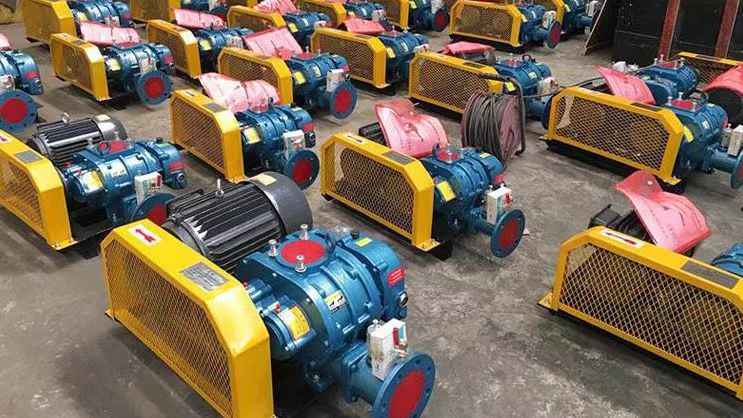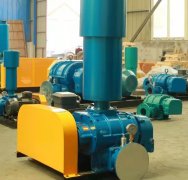The working process of Roots blower is based on the principle of volumetric gas delivery, which achieves gas suction, closed delivery, and forced discharge through the rotational motion of a pair of interlocked rotors in a closed chamber. The following is a detailed analysis of its working process:
---

**1. Core working principle**
Roots blower belongs to * * positive displacement fan * *, and its working process can be divided into three stages:
**Inhalation → closed conveying → exhaust * *, with no internal compression * * throughout the process (pressure determined by the resistance of the exhaust side system).
---
**2. Step by step detailed explanation of the work process**
**(1) Inhalation stage**
-* * Rotor position * *:
Two rotors (usually three bladed) rotate in opposite directions under synchronous gear drive, and when the rotor peaks detach from the air inlet, the cavity volume increases.
-Gas inhalation:
The intake creates negative pressure, and external gas is drawn into the enclosed chamber formed by the rotor and the casing.
-* * Features * *:
-The inhalation process is continuous without valve control.
-The flow rate is determined by the rotor speed and chamber volume (independent of pressure).
**(2) Closed conveying stage**
-* * Rotor rotation * *:
The rotor continues to rotate, sealing the inhaled gas inside the chamber and pushing it along the inner wall of the casing towards the exhaust port.
-* * No compression feature * *:
-During the transportation process, the volume of the gas remains unchanged and the pressure does not actively increase.
-Pressure is only formed in reverse by system resistance (such as pipelines, liquid levels) when it is forcibly discharged.
**(3) Exhaust stage**
-* * Forced discharge * *:
When the rotor peak is connected to the exhaust port, the volume of the cavity decreases and the gas is forcibly squeezed out into the exhaust pipe.
-Pressure formation:
-The exhaust side resistance (such as the water depth of the aeration head) forces gas compression, at which point the outlet pressure of the fan equals the system resistance.
-If the exhaust is blocked (such as when the valve is closed), the pressure will continue to rise until the valve is activated.
---
**3. Dynamic Process Diagram**
```
Inlet side:
Rotor A peak detachment → cavity V increases → suction
The convex peak of rotor B is closed → the gas is locked
Exhaust side:
Convex peak engagement of rotor A → reduction of cavity V → exhaust
Rotor B peak opens → gas is pushed out
```
---
**4. Key characteristics**
-Hard wind characteristics:
Constant flow rate, adaptive pressure with system resistance (commonly 0.1~0.8 bar).
-Oil free transportation:
There is no lubrication between the rotors, and the gas is pure (suitable for the food and pharmaceutical industries).
-Pulsation and Noise:
The three bladed rotor has smaller pulsation than the two bladed rotor, but there are still periodic airflow fluctuations (requiring a muffler).
---
**5. Difference from centrifugal fan**
|* * Features * * | * Roots blower * * | * * Centrifugal fan * *|
|-------------------|-----------------------------|---------------------------|
|* * Working principle * * | Volumetric (mechanical extrusion) | Kinetic (impeller acceleration)|
|Flow pressure relationship | Flow rate is constant, pressure is determined by the system | Pressure decreases with increasing flow rate|
|* * Efficiency * * | Low pressure (60-80) | High pressure (70-90)|
|* * Applicable pressure range * * | Low pressure (<0.8 bar) | Medium high pressure (up to several bars)|
---
**6. Performance in typical applications**
-Sewage treatment aeration:
-Water depth of 4 meters (≈ 0.4 bar) → The fan continuously delivers a constant amount of air, and the pressure automatically balances to 0.4 bar.
-* * Pneumatic conveying * *:
-Pipeline resistance 0.6 bar → The outlet pressure of the fan stabilizes at 0.6 bar, and the material is driven by the airflow.
---
**7. Precautions**
-* * Avoid overpressure operation * *:
Exhaust blockage can cause motor overload, and a valve needs to be installed.
-Temperature rise control:
Without internal compression, there is a significant adiabatic temperature rise (Δ T ≈ 10-30 ℃), and cooling is required for high-temperature conditions.
-* * Startup method * *:
It should be started without load (with the outlet valve closed) and slowly loaded after operation.
---
**Summary**
The Roots blower achieves constant volume delivery of gas through precise engagement of the rotor. Its working process is simple and reliable, making it particularly suitable for low-pressure, high flow, and stable flow scenarios. When selecting, it is necessary to match the system resistance and pay attention to auxiliary designs such as sealing and cooling to ensure long-term stable operation.



